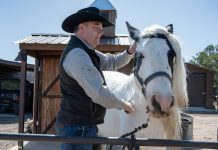An incident with a man, two dogs and a defensive cow moose with two calves has prompted Colorado Parks and Wildlife to remind people to keep their distance from wildlife, especially mothers with young. The incident occurred on private property near South Meadows Campground, north of Woodland Park.
On Monday, a man was chased down by a female moose and knocked to the ground while he was letting his dogs back inside. The man had to roll under a vehicle to escape the attack, and witnessed his two dogs get stomped on by the moose. One dog was euthanized due to the injuries it sustained while the other is still under observation. On Sunday, the man’s wife was also charged by the moose, but escaped inside the home.
Due to the location of the incident, CPW attempted to sedate and relocate the moose and its calves but observed the moose moving into better and more remote moose habitat. CPW has posted signs in the area warning that a potentially dangerous moose may be in the area.
“This incident is a reminder of why we warn everyone to respect wildlife and give them their space,” said Travis Sauder, CPW Assistant Area Wildlife Manager. “We know Colorado residents love their dogs. But it’s important to understand that moose see dogs as predators and react in defense of themselves and their young.”
CPW says the moose population in the state is growing, especially in Teller County. There are currently estimated to be 3,600 moose in the state, compared to 2,250 in 2013. With more people moving into Colorado and a growing moose population, it’s becoming especially important to take precautions when recreating or living in mountainous areas of the state.
“This cow moose was exhibiting classic protective behavior of its calves,” Sauder said. “Be sure to give wildlife extra space, especially when they are raising their young. And it is always best to keep dogs on leashes or in a fenced area to reduce the chances of an incident with wildlife.”
As a precaution against run-ins with moose, Sauder urged hikers to avoid thick willow habitat in riparian areas where they are likely to be found eating or resting. Their calves, born in a 3-4 week period from the end of May to mid-June, are often lying in the willows while their mother is off grazing and will stay with their mother into the fall.
If photographing or observing wildlife, especially wildlife with young, always keep a safe distance. Called the ‘rule of thumb’, if you can cover the entire wild animal with your thumb you’re generally at a safe distance. If the animal looks larger than your thumb, you are too close and need to back away slowly. If the animal changes its behavior at all–looks toward you, tucks its ears, makes noises, stomps the ground, etc., then you are too close and need to back away slowly. This is also another reason to not feed wildlife as this can encourage animals to approach people looking for food.
Near your home, keeping pets on a leash or in a fenced in area is ideal. If that is not possible, it is recommended that you canvas the area before letting your dogs outside, and remain outside with them to watch out for wildlife. Understand that a pet left outside, unsecured and unobserved, may be in danger from moose, bears, and mountain lions as well as foxes, coyotes, bobcats, and even raptors like owls, hawks and eagles.
CPW produced a video illustrating how people can be safe and responsible around moose. The video is available on YouTube.
Please visit our website to learn how to safely coexist and live with wildlife in moose country.




